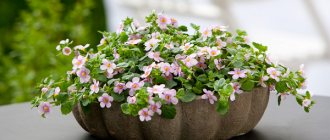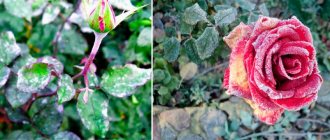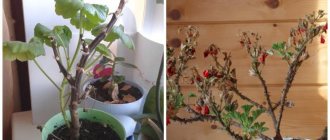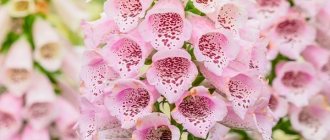Pests
Sometimes the leaves of indoor roses slightly change color to a lighter shade, which many confuse with yellowness.
At the same time, the old leaf plates begin to wither, and the young ones grow deformed and pale. This indicates the presence of pests in the root system area. Carefully move the soil away from the base of the trunk and a little deeper. This is where harmful larvae or worms live. Some sources recommend catching parasites with tweezers. Give it a try. And it’s good if there was only one worm. What if the soil was more contaminated? Are you going to use tweezers all over the pot? During this time, the indoor rose will simply bend.
Don't rely on your sleight of hand, it may not be enough. Use any broad-spectrum or long-lasting systemic insecticide. Be sure to repeat the soil treatment in a month.
Advice. Be sure to replant your indoor rose from store-bought soil into your own. But only after disinfection by freezing or heating in the oven.
Choosing roses for cuttings
To get a high percentage of rooting, the choice of planting material must be correct. Not all varieties root equally well.
The easiest varieties to adapt are those that can be cut:
- Pleiades, especially small-flowered varieties.
- Polyanthas and hybrid polyanthas reproduce well, producing green shoots in the summer and partially woody shoots in the fall.
- Soil cover.
- Miniature ones take root easily, even with water.
- Floribunda varieties take root twice as fast.
Varieties with a strong root system include:
- parks;
- large-flowered Plated;
- shrubs;
- Most tea hybrids.
Successful seedlings also depend on the color of the flower. The most suitable are burgundy, red, then pink and white. Yellow ones are the most difficult to take root, have the lowest survival rate among all planting material and most often die from infection.
Dangerous pests
Aphids, thrips and spider mites are the most common pests of house plants, due to which they often get sick and dry out. They are easy to spot. Usually both the insects themselves and traces of their activity are visible. The presence of parasites is indicated by gnawed areas of indoor rose leaves and small dark spots on them. The presence of a tick will be revealed by a spider web, which is usually located under the foliage. If such signs are found, it means that the flowers wither for this very reason.
All affected parts of the plant are carefully removed. Then treatment is carried out with special solutions against insects.
It is recommended to do this as a preventive measure in the summer, even if the pests are not visible.
Causes of yellowing leaves of indoor roses
The reasons for yellowing of leaves can be very diverse, for example, sunburn. The fact is that direct sunlight is destructive, not only for the leaves of an indoor rose, but also for its flowers. It is best to keep this plant near windows that are directed to the southwest or southeast.
But there are several other possible reasons why the leaves of an indoor rose begin to turn yellow:
- watering the plant with too cold water;
- overdried substrate;
- draft;
- overflow
For normal functioning, indoor roses simply need fresh air. In this regard, in the summer it is best to keep it either on the balcony or on the terrace. You can also take a flowerpot with a rose to a flowerbed and bury it a little in the ground. If you live in an apartment and you don’t have this opportunity, you can keep the rose just next to an open window, while avoiding drafts. Thanks to such manipulations, an indoor rose can easily withstand even the strongest sun.
We present to your attention several possible reasons for the change in leaf color of indoor roses:
- if your indoor beauty does not have any pests and is not sick with anything, but its leaves still turn yellow, this may indicate that the plant lacks some nutrients;
- if the leaves of an indoor rose become pale green and turn yellow from the midrib, this directly indicates a lack of nitrogen;
- yellowed leaves with spots are evidence of potassium deficiency. And if yellowing is visible between the veins of the foliage, it means the plant lacks iron;
- Interestingly, rose leaves can turn yellow even if the plant receives too many nutrients. In order to prevent this, it is necessary to adhere to the correct dosage of fertilizer, which is indicated on the package;
- The plant should be fertilized on time, especially during the flowering period. The fact is that at this time the rose is greatly depleted and requires additional nutrition. If this is not done, the leaves of the plant will be yellow and limp, and the number of flowers will be insufficient;
- Another cause of yellow leaves may be chlorosis. The main signs of its presence are yellowing of the leaves, but with green veins, as well as yellow spots on green leaves. In order to combat this disease, as well as to prevent the disease, you should use a water-soluble iron chelate fertilizer. They need to not only water the plant, but also spray it.
Remember that another reason for yellowing of the leaves of an indoor rose may be its improper replanting. This plant must be replanted once a year, preferably in February
This is done by transshipment, but with extreme caution so as not to damage the roots of the plant in any way. An already transplanted plant should be moved to a warmer place.
By the way, when replanting a plant, it is necessary to change not only the soil, but also the pot. Every year its diameter should increase by 2-3 centimeters.
Timing of cuttings of roses
The planting date depends on the climate zone, as well as on the variety of rose and the method of shoot formation. In the warm season, the preparation of planting material and its rooting can be carried out twice. This occurs in mid-spring: in April and May in greenhouses. This is mandatory for some imported roses, which are first grown in greenhouses and then finished outdoors.
The best time for propagation is mid-summer: late June or early July, when the shoots are just beginning to become woody. This usually happens before flowering, when the buds take on color. Seedlings used later have a lower rooting percentage.
Often, after autumn pruning, parts of the bush remain that are a pity to throw away, and gardeners try to save them for later planting in the spring. To prevent most shoots from freezing, follow these steps:
- Remove all leaf blades and spines.
- Seal cuttings with paraffin to prevent premature germination.
- Store the seedlings in a cool place: in the cellar, basement or in the lower compartment of the refrigerator.
Diseases that cause yellowing of roses
One of the common diseases of indoor roses is powdery mildew. Leaves, stems and buds are affected by fungi. First, a light fluffy coating appears, then it begins to darken, and brown spots form. The leaves turn yellow, become deformed, and curl. If you do not immediately react and treat the plant, it will die. At best, its growth will stop, the foliage will fall off, and the flowers will lose their petals. The rose will lose its attractive appearance.
All affected parts of the plant will have to be removed, otherwise it will not be possible to defeat the disease. It spreads rapidly and also easily spreads to neighboring flowers. Spores are carried on the hands after working with an injured representative of the flora, and easily move through the air.
Note! At the early stage of the disease, when the leaves seem to be sprinkled with flour, and the plaque is wiped off with your fingers, you can use a solution of soda with added soap. If the plant does not recover, it is better to resort to fungicides
Black spots may appear on the leaves of indoor roses. They have jagged edges and are clearly visible. At the same time, the leaf blades themselves turn pale, turn yellow, and wither. Over time, the spots grow and merge, and may appear on shoots. Plant growth slows down and flowering does not occur. The affected leaves fall off, new shoots are formed, which do not have time to gain strength and immediately encounter the disease. A systemic fungicide will help cope with it. The substance penetrates the plant and promotes its recovery.
If yellow-red spots are noticeable on the rose, then rust has appeared. The main reasons are high temperature at home and stale air when the room is rarely ventilated.
Rust appears due to stuffiness
How to deal with the disease: fungicides and traditional medicines
If a focus of phyllostictosis is detected, it is necessary to immediately remove damaged leaves and stems or cut off with a knife the part that has been damaged by the virus.
Fungus-infected and dying rose leaves
What means to treat
A fresh cut should be immediately sprinkled with crushed activated carbon powder. After finishing work, wash your hands well and disinfect the tool blade with alcohol.
Fungal rot phyllostictosis
At the initial stage of phyllostictosis, these measures may be quite sufficient to stop the development of the disease. But if it progresses, you must immediately seek help from fungicides. These can be drugs such as Ikstra, Abiga-Pik, Strobi. The aqueous solution is prepared strictly according to the instructions and immediately before use.
Also good helpers for treating rose leaves are preparations containing triazole (this is Topaz and Skor) and mancozeb (this is Ridomil Gold or Profit). They must be applied alternately, with an interval of one week. Processing should be done three times.
Folk remedy
The folk method gives a good result in the fight against phyllostictosis; it consists in preparing a solution:
- You will need 200-300g of soap (you can use liquid soap) and 30g of copper sulfate.
- First, the soap is dissolved in a liter of warm or hot water during the day;
- There is no need to soak copper sulfate, but you shouldn’t add it to the soap mixture; it’s better to stir it in 100-200g of water;
- Then copper sulfate is carefully poured into the stirred soapy liquid.
To prevent the mixture from coagulating (when using hard, untreated water from wells and wells), 5 g of soda must be added to the solution. Then they begin to spray the diseased bushes.
Improper watering
If you water your flowers incorrectly, you can seriously harm them. Cold water should not be used to water roses. As a result, the bush becomes sick, stops growing and dies over time. The water should be soft and settled. Some gardeners advise boiling it.
The frequency of watering can be selected according to the condition of the soil in the pot. If its top layer begins to crack, moisturizing is necessary. Mature plants are watered two or three times a week. In the summer heat, you can water them more often and install a humidifier in the room.
The foliage of indoor roses often turns yellow due to improper watering of the plant. This can be either overwatering or insufficient watering. Overdrying of the flower, in addition to its yellowing and loss of leaves, may also be indicated by a general depressed appearance and the appearance of cracks in the soil. If overwatering occurs, the symptoms will be somewhat different: yellowing of the foliage in this case is accompanied by lethargy of the plant, its wilting, and the presence of a “swamp” in the pot.
Lack of lighting or moisture
Do not forget that roses love light and warmth. Planting it in dark, cool places leads not only to spoiled leaves, but also to withering of the bush, and sometimes to its death. Plant the plant in sunlit areas where there are no drafts. But the rays should not hit the flower all day. It is best when the sun is warm in the first half of the day, and in the evening the rose is slightly cool.
The rose also loves moderate moisture. It should not be watered too often, but regularly. Make sure that there is no stagnation of water in the soil. It is imperative to ensure moisture removal. Using these rules will help you in the future not to rack your brains over why the rose is drying up.
Why do rose leaves turn yellow?
Most often, yellowing of foliage is caused by the following reasons:
- Lack of mineral fertilizers. Depending on what the plant lacks, it turns yellow in different ways. When a crop needs nitrogen feeding, it turns yellow completely, starting from the lower leaves. Application of universal fertilizers or urea can help. If a rose lacks iron, it begins to turn yellow in spots - from top to bottom. In this case, any acidifying fertilizer will do.
- Excess feeding. Excess mineral fertilizers can also lead to leaf fall. When the flower is weakened and you want to feed it, it is better to start with half the dose, otherwise you can burn the roots.
- Pests and diseases. One of the most common diseases is chlorosis. You can fight it with the help of Antichlorosin, which dissolves well in water. The plant is watered with it twice during the growth period, and then once every two weeks, if necessary.
- Excessive humidity. Although roses love moisture, excess is harmful to it, otherwise it will begin not only to turn yellow, but also to rot. Finding a middle ground is not difficult - it is enough to provide good drainage and water the plant as soon as the top layer begins to dry out. In addition, it is useful to spray it with warm water from a spray bottle.
For what reasons does a rose lose leaves and buds?
The rose is a delicate plant and reacts sensitively to any changes in conditions, not to mention various pests and diseases that can significantly damage the flower and even lead to its death.
If the leaves of rose bushes begin to fall off and the buds fade, the reason must be sought in the following:
- improper watering or location,
- unfavorable weather conditions,
- lack of nutrients
- presence of diseases and pests.
What to do if your houseplant drops its leaves?
There are several reasons why this whimsical plant sheds its leaves and dries up:
- Physiological aging is when a flower, at the final stage of its life, begins to shed its leaves and buds.
- Seasonality - when an indoor flower sheds its leaves in the fall so that new ones grow in the spring.
- Violation of the light regime - lack or excess of sunlight.
- A change in weather or a change in the microclimate of the house - a change in air temperature and humidity level in the room, the appearance of a draft or the start of heating devices in the house affect the condition of the rose.
- Violation of the irrigation regime - lack or excess of moisture in the soil.
- Presence of pests – parasites dangerous to flowers, especially spider mites, can destroy a plant in a matter of days.
- Unsuitable soil - a lack or excess of nutrients in the soil leads to the fact that the flower begins to hurt and wither.
- The rose is damaged by pathogenic microflora - the flower begins to rot or black spots appear on it.
- Carefully examine the flower. If the leaves turn yellow and fall off on one side, this may indicate an excess of sunlight. In such a situation, it is necessary to provide the rose with diffused light.
- Check the soil in the pot. If the pot has cracked, dry soil, you need to start watering it regularly. For irrigation, use pre-settled water at room temperature.
- Remember the last time the soil of the rose was changed. If it was more than a year ago, then it is advisable to urgently start feeding the plant. But you should carefully study the instructions and strictly follow them so as not to overfeed.
- Check leaves and stems. If pests are detected, it is recommended not to delay the start of treatment. In this case it is necessary:
- Isolate the rose from other plants.
- Use a sterile blade to trim off all affected areas.
- Treat with parasite repellent according to instructions.
If a rose drops all its leaves in the shortest possible time in spring or summer, this means that:
- The flower is located in a room with very dry air. What to do in a situation if the plant has dropped all its leaves:
- Move it to another room or install a humidifier nearby.
- Water the flower regularly and do not allow the soil to dry out.
The flower was infected with a dangerous disease. In this situation, the action plan is as follows:
- Trim off all affected areas of the flower and remaining buds with a sterile blade.
- Treat the plant with special means.
A rose that has dropped all its leaves will take a long time to recover, so it is recommended to be patient and wait, while observing the light and watering regime.
How to solve the problem with dry leaf tips?
General hygiene measures
Regardless of the results of the assessment of the causes, the first step is to take general hygiene measures:
- Start by removing the risk of soil contamination and eliminating salt deposits: remove white deposits from the surface of the substrate, replace the surface layer of soil with fresh, clean substrate.
- Be sure to clean the leaves of the plant from dust, give it a shower and monitor the “behavior” of your pet.
- Try changing the humidity by placing a container of water or humidifiers nearby.
These measures must be taken regardless of whether the cause was found and what it was. After all, even if the plant is infected with pests, increasing humidity will serve as a preventative measure.
But steps 2 and 3 also have their exceptions:
- obvious waterlogging of the substrate, leading to rotting of the shoots, during which it is possible to clean the leaves, but it is better not to increase the air humidity until the soil dries out;
- if the problem manifests itself on plants with pubescent leaves that cannot be cleaned of dust using classical methods, then it is better to avoid cleaning and showering.
The tips of the guzmania leaves dry out.
© Newma The second important step is also general – individual care. Indoor plants are all different, and they also need far from the same care. You cannot add orchids, chlorophytum and cacti with the same frequency. Each plant should receive exactly the care (and conditions) that it needs. Review your exit strategy and make sure you're sticking to it. If not, rebuild your care program by studying information about each plant.
Further measures depend directly on the cause of drying of the tips of the leaves.
If the tips of the leaves dry out due to dry air
The problem with dry air can be solved using standard methods:
- spraying (not suitable for flowering plants and pubescent leaves);
- installation of special humidifier devices;
- installing pallets or trays with wet pebbles, moss, expanded clay, on which the pot with the plant is placed so that the bottom does not touch the water;
- placing plants in flower displays.
If the tips of the leaves dry out due to water quality
If the drying of the leaf tips of your plant is caused by water quality, immediately make changes to your usual watering schedule:
- check what kind of water is recommended to water your plant (it may need acidified or especially soft water);
- refuse to use running water, let it sit for at least 24 hours (or better yet, several days) in containers, then carefully strain;
- replace tap water with rainwater, melted water, or boiled water.
If the tips of the leaves dry out due to improper watering
If the cause of the problem lies in an incorrect watering regime and a violation of the comfortable humidity of the substrate, the actions should be different:
- Find out about the basic preferences of the plant (today, for most species, the recommendations of “poor or abundant watering” have long been replaced by more precise instructions).
- in case of overmoistening, which has already led to the process of rotting and disruption of the air permeability of the soil, evaluate the quality of the drainage and drainage hole. If everything is fine with them, let the substrate dry almost completely before the next procedure and postpone watering. If the problem is a small drainage hole or lack of drainage, proceed with emergency plant replanting.
- If there is excessive drought, make watering more frequent and abundant. But do not let the water stagnate in the trays; still carry out each subsequent watering after the top few centimeters of soil have dried for moisture-loving plants and the middle layer has partially dried for ordinary crops and succulents.
- Consider purchasing pots with automatic watering, which will save you forever from the hassle of individually selecting the frequency of procedures.
The tips of the anthurium leaves dry out. © erikarizkallah
If the tips of the leaves dry out due to pests
If the plant is infected with pests, begin comprehensive control:
- isolate the plant from other indoor crops to prevent the spread of pests;
- wash the leaves with soapy water;
- increase air humidity;
- start using special insecticides (you can check out a range of preparations, both biological and with a purely chemical composition, at the nearest flower shop or garden center);
- When replanting a plant, carefully treat and disinfect the container;
- Strengthen preventive measures for the remaining plants in the collection.
If the tips of the leaves dry out due to violation of maintenance conditions
If the reason for the drying of the tips of the leaves was disturbances in lighting, temperature, or feeding regime, then the conditions must be returned to those that are comfortable for a particular species and variety of plants. If there are obvious signs that the plant is cramped in its container, carry out an emergency transplant. It is also carried out if the excess nutrients cannot be corrected by simply reducing feeding.
www.botanichka.ru
How often, after buying an indoor rose, a gardener is disappointed - the plant’s leaves begin to dry out or, even worse, fall off. You will find out what is the cause of the disease and how to restore a rose at home by reading today’s article.
Why do rose leaves dry out?
Rose leaves can dry out, both in the garden and at home, and often the reasons are the same: poor care, change in weather, stress.
No less alarming for the gardener should be the appearance of yellow leaves, blackening or drying out at the edges, as well as excessive falling and other untimely changes.
Possible reasons why rose leaves dry out:
- Disease
- Change of weather
- Pests
- Insufficient feeding
- Weakening of the root system
- Stress
Fungal diseases of roses
Fungal spores can fall on the leaves and roots of roses at home or in the open ground, disrupting the normal state of the plant. In open ground they are introduced through fertilizers, soil or through dew from a bud. At home, the leaves of roses can dry out due to fungal infection, possibly due to poor-quality soil or fertilizers, as well as increased air humidity in the room or waterlogging against the backdrop of a drop in temperature.
Root damage, root collar diseases of roses
Damage to the root system of roses can occur due to mechanical trauma, improper transplantation, or as a result of prolonged infection by fungi. Pathogenic fungi that cause root damage are usually found in the soil mixture.
Rose pests: spider mites
Roses may dry out (buds and leaves) due to pest damage. Especially often, rose leaves dry out due to spider mite infestation. Roses often suffer from chafer larvae, as well as worms and caterpillars. It is important for the gardener to ensure that the soil mixture for planting has been tested, clean, and the ingredients, especially sand, have been disinfected. Oversaturation of soil fertilizers can lead to similar problems.
In open ground, the root system of roses suffers from moles, mice, worms and caterpillars. Due to malnutrition of roses, leaves begin to dry, buds fall off, and the bush withers.
Other possible pests on roses:
- Leaf beetles
- rose aphid
- Thrips
- Nematodes
- Zlatka
- Sawflies
Common diseases of roses:
- Rose spotting (brown, gray, purple, etc.)
- Bronzing virus
- Bacterial stem cancer
- Jaundice
- Burn
- Cortical necrosis
Fertilizers for roses - why do the leaves dry out?
The leaves of roses can dry out due to an excess or lack of fertilizer in the soil mixture - this is a tale of two ends. It is important to observe moderation in caring for roses, and also wisely adjust the feeding time depending on weather conditions, needs and condition of the plant.
In rainy, cloudy times, roses are especially susceptible to excess moisture, so they cannot be fertilized with liquid fertilizers. Roses are fastidious plants that require close attention, but moderate, even delicate, reasonable care will protect roses from damage by bacteria, fungi, and pests, and prevent the occurrence of diseases caused by improper care.
How to save an indoor rose after purchase
The rose is a difficult flower to keep at home; it is quite demanding and capricious. It is not enough to become the happy owner of this beauty, you also need to preserve the flower and find an approach to it, otherwise sad consequences will not keep you waiting.
Yes exactly. The purchased plant usually looks fresh and full of vigor, blooms amazingly and it seems that it will always be like that.
In fact, the plants arrive on the counter fed with all kinds of stimulants; in addition, they have special packaging that retains high humidity. Once on our windowsill, roses are deprived of all this.
Almost immediately, inexperienced gardeners have problems: the roses begin to turn yellow, their leaves dry out and fly off, the buds fall off and turn black. Rosette orders to live long and disappears, leaving behind nothing but frustration.
It should be noted that the rose is considered an open ground plant. Some varieties are more suitable for indoor use than others. But this does not mean that keeping them in an apartment is an easy matter.
So, what steps should you take when you bring a rose home:
Remove the packaging wrapper, if any. Although the packaging helps to retain moisture, it often causes the rose to become infected with fungal diseases while still in the store, because... packaging interferes with air exchange, creating an ideal environment for fungi. Use pruning shears or scissors to remove all wilted leaves, blackened and dried stems that are on the plant. Flowers and buds also need to be trimmed. Of course, for the sake of them we buy a plant and we would like to admire them to our heart’s content, but the plant, the flowering of which was stimulated by special preparations and greenhouse care, subsequently simply cannot withstand such abundant flowering, and, having given all its strength to it, dies
Therefore, we cut off all the flowers and buds that are present on the plant, along with the supporting stem. Pay attention to the number of bushes in the pot. Growers of indoor roses often plant several plants in one pot to create the appearance of a lush flowering bush.
Crowded plants weaken each other and there is a lack of nutrients. Bushes, if there are several of them, must be planted in different pots.
After transplantation, it is necessary to treat the rose with antifungal drugs (Fitosporin) and pest control drugs (Fitoverm).
The buds of a garden rose are drying: what it looks like
A wilted, dried out, non-viable bud is a condition when a flower bud develops normally and even swells to full size, but its petals do not open. The bud is often soft and slippery to the touch, and the outer petals gradually lose color and turn brown. Eventually the entire bud sticks together and merges into one. It may then remain on the stem or fall off, becoming dry and crispy on the outside. If the outer petals are separated from each other, the inner petals appear normal, but this is misleading, especially if the buds are drying up due to disease.
Another condition is when there are buds, they begin to open, but they look frail. The flower itself is underdeveloped, and even if it opens completely, it will look ugly and dull.
Caring for an indoor rose after purchase - how to preserve a flower
The indoor rose is a very delicate flower and capricious to environmental conditions, so you should take care of this beauty from the first days of its acquisition. The fact is that in flower shops, roses in pots are fed with special preparations, thanks to which they maintain their ideal appearance; in addition, the packaging of the plant helps maintain the required humidity level.
- Remove the cellophane packaging - in apartment conditions it will not maintain the required level of humidity, but will cause poor air circulation and the appearance of pathogenic bacteria and fungus;
- Cut off all non-living leaves and stems with sharp scissors; the same should be done with leaves that have defects - spots, dried tips;
- Remove flowers and growing buds, no matter how sorry it is - if you give all the emerging buds the opportunity to bloom, the rose will lose all its strength and die;
- Plant a rose if several bushes are planted in one small pot (as a rule, in stores they do this to give the flower a lush shape) - this way there will be enough nutrients in the soil for each bush;
- Treat your home rose with drugs against fungus and parasites (Fitosporin, Fitoverm).
Replanting an indoor rose after purchase is necessary if the pot is too small for it - in this case, the flower is carefully removed from the old flower garden along with the soil, the brown and black roots are removed (the healthy color of rose roots is white), rotten parts, then the plant is placed in a new pot with properly selected soil. The soil for roses can be prepared independently; for this you will need:
- Compost;
- Leaf humus;
- Soil from under coniferous trees;
- Turf soil;
- Clean sand.
The listed components are mixed in a ratio of 1:1:1:3:1, the soil mixture is poured into the flower garden on top of the drainage. The rose is placed in a new pot along with an old lump of earth, firmly fixed and watered with warm water. It is recommended to treat the newly transplanted plant with a drug to enhance immunity - Epin is ideal.
A rose in a pot dries up: what to do
When asked what to do if a decorative rose in a pot dries out, you should first of all answer that indoor roses require more attention compared to their garden relatives, as a result of which the reasons why a rose dries out are more varied. So, very often the leaves begin to turn yellow and dry out immediately after purchasing them.
This is one of the signs that the plant is undergoing acclimatization, which is caused by a sharp change in growing conditions. This procedure can take up to several weeks, during which the plant only needs to be placed in a bright place and periodic irrigation is carried out. After the specified period of time, the plant will get used to the new conditions, but during this time it may dry out and fly off most of the leaves.
For your information! The houseplant can be damaged by typical rose pests. You can cure a damaged bush with the help of insecticides.
In excessively hot conditions, an ornamental rose will not grow normally. In addition to regular watering, the pot with the bush also needs to be placed correctly. So, in winter, you should move the container away from warm radiators. Insufficiently intensive watering is also one of the reasons for the leaves to dry out. The next watering is carried out immediately after the soil dries slightly after the previous irrigation. The best option for adding liquid is to water through a tray. This method will allow the rose to take the required amount of water on its own, and the remaining liquid is then drained.
Drying of indoor rose foliage is often accompanied by simultaneous rotting of the root system. This is caused by an excess of moisture, which can be caused by too compacted soil, in which the liquid does not have time to dry. In such a situation, the bush is dug up and cleared of old soil. The affected roots are shortened to healthy tissue, and then washed in a solution of potassium permanganate. After this, the plant is placed in a fungicidal solution for half an hour. Upon completion of all these procedures, the rose is ready to be transplanted into clean and disinfected fresh soil.
The rose must be fully provided with all the necessary nutrients. If some of them are deficient or absent, plants begin to become deformed in one way or another. In particular, this manifests itself through drying of the leaves. This is especially true for elements such as:
- iron;
- potassium;
- manganese.
Knowledge of agricultural technology greatly facilitates the work of a gardener and can make it much more efficient. Competent and timely measures can revive a drying plant and help it quickly recover, preventing it from shedding its leaves and drying out completely.
0 0 votes
Article rating
Pests and feeding
Rose, like many other indoor plants, is very afraid of spider mites. Determining the presence of such a pest is quite simple. The leaves begin to fall and small bugs can be seen climbing on them. If you turn the leaf over, you can see a characteristic white coating on its back side. To solve this problem, you need to use special preparations that are sold in flower shops. Spraying the flowerpot is carried out according to the instructions on the product packaging.
Roses are quite capricious and demanding plants. For normal flowerpot growth you will need a sufficient amount of minerals and trace elements. A lack of any element will negatively affect the plant. So, if a flower lacks magnesium, its leaves begin to fall off over time. In the case of a lack of nitrogen, they stop growing and change their color. To prevent such changes, it is necessary to feed the plant in a timely manner. To do this, it is worth using special fertilizers designed specifically for flowering flowerpots.
A common cause of discoloration and falling leaves is excessive flowering. The development of buds and flowering takes quite a lot of effort. When there is a lot of color, the leaves become defenseless and are easily susceptible to diseases, pests and various changes. This problem is solved with the help of special fertilizers and preparations that are sprayed on the flowerpot. With their help, you can strengthen the flower’s immunity and supply it with all the microelements and minerals for full growth and development. All medications must be used in accordance with the instructions.
Yellowing of roses due to lack of nutrients in the soil
The beginning of yellowing or falling leaves can be explained by a lack of useful elements in the soil. The most important substances that influence the development of culture include the following:
Iron
Why do rose leaves turn yellow outside in summer?
A deficiency of this substance provokes the development of chlorosis. With this disease, the foliage becomes yellow, decreases in size and curls.
To cope with the problem, it is worth using products such as Ferrilene, Ferovit. The ampoule of the composition must be mixed with water and sprinkled on the plants.
Nitrogen
This product is responsible for the condition of the green mass. A deficiency of the element provokes blanching of the foliage and its gradual yellowing.
Roses have a special need for the element in the spring. In this case, you need to add ammonium nitrate. It is also permissible to use a combined composition.
For reference! It is worth considering that excess nitrogen can cause fungal pathologies, which negatively affects the condition of the bushes.
Potassium
If there is a lack of this element, the edges of the leaves dry out in the plant. At the same time, the veins remain green. After a certain time, the leaf blades turn completely yellow and turn red-violet.
The rose should be fed with potassium magnesia. A large amount of potassium provokes developmental delays.
Manganese
Affected foliage acquires a yellow tint between the veins - from the edges to the central part. A green border appears around the veins. In this case, only old leaves turn yellow. The rose needs to be fertilized with manganese sulfate and the soil deoxidized. You can add peat to it. Ammonium sulfate will also work.
Magnesium
If there is not enough of this substance, dark red spots appear between the veins. The edges of the leaves remain green. At the same time, they are observed to fall off.
To avoid such problems, you need to regularly add ash to the soil. Magnesium sulfate will also work. In this case, the increased content of the substance provokes a violation of the absorption of potassium.
Insufficient application of fertilizers provokes the appearance of a yellow border on the foliage.
Pale and light leaves
Healthy and young leaves should not just fade for no reason. This means that there is a violation in agricultural technology or the rose has already begun to develop a disease.
- If roses do not have enough nutrition, the leaves will turn pale and wither. Don’t forget nitrogen in early spring and complex fertilizing throughout the season;
— Young shoots grow sickly if the bushes are planted too close to each other. They are cramped and absorb all the elements from the ground;
- A rose will always be light and pale if it constantly lacks sun. This disrupts the process of photosynthesis, so for planting in the shade you need varieties adapted to such conditions.
Detrimental factors affecting flower development
First you need to figure out why the leaves of an indoor rose turn yellow. Often, to solve this problem, it is enough to move the pot to another place where there is no direct exposure to sunlight - then the condition of the flower will normalize. But it happens that the reasons for yellowing of leaves lie in other unfavorable conditions for the development of the plant.
Unfavorable factors for roses
If you water with too cold water, you should water with water at room temperature. Drafts - it is recommended not to keep the plant under an open window. Abundant or, on the contrary, rare watering - the rose requires optimal moisture content in the soil. Lack of fresh air - in summer you need to take the pot out onto the balcony or terrace. Lack of nutrients - roses definitely require regular feeding. Incorrect replanting - if you need to move the plant into a large container, this should be done with the utmost care, and the month chosen for such actions is February. In this case, the rose has a better chance of taking root. Powdery mildew is a white coating that appears when there is excessive application of fertilizers or lack of fresh air. Rust – appears in the form of bumps
The reasons for its appearance are abundant watering and high room temperature. Thrips - appears at low humidity, it gives the leaves a gray-yellow color. Spider mites are caused by too dry air or insufficient space for plants.
Preventive measures
What diseases of begonia can there be - how to fight them
There are several preventive measures that will help prevent roses from drying out prematurely:
- water correctly. For irrigation you need to use settled and warm water. In winter, it will have to be heated to room temperature;
- preventive spraying. At least twice a season it is necessary to treat flowers with fungicidal and insecticidal agents;
- regular feeding. To prevent the tips of leaves and leaf blades from turning yellow, you need to add mineral and organic fertilizers to the soil 2-3 times a month.
Only prevention will help you grow beautiful flowers.
Leaf drying is a fairly common problem that some gardeners encounter when growing roses. Therefore, every person who is going to plant such flowers should figure out why they dry out, as well as familiarize themselves with preventive measures to prevent the problem.
Transplanting an indoor rose
To replant a rose, remove it from the previous pot along with the earthen lump. Assess the condition of the roots entwined in the ground.
If the roots are hair-thin, brown or blackened, dry or rotten, the plant will most likely die. You can try to save it: cut cuttings and try to root them.
Healthy roots are bright white or yellowish in color and look quite dense, like a thin wire. If the roots are only partially missing, you need to remove all the rotten and damaged ones, leaving the healthy ones.
Place expanded clay or other drainage at the bottom of the new pot.
It is better to purchase a soil mixture ready for roses or a garden mixture. Do not use cheap soil; it contains a lot of peat and few nutrients. It is better to choose a higher quality soil mixture.
Fill the drainage with soil and compact it a little. Place the rose bush together with a lump of earth, cover it with new soil, periodically compacting it so that the bush does not dangle in the pot, but is well fixed. Water with settled or filtered water at room temperature.
Treatment against diseases and pests is necessary. A pruned and replanted plant is weakened and susceptible to disease, even if it was well cared for at the store and no infection occurred. Therefore, it is better to play it safe and process it.
Also, after transplantation, treatment with Epin is effective - it will strengthen the plant’s immunity and reduce stress from transplantation.
Spray your plant; it requires high humidity, especially in conditions of operating heating and dry air in the apartment. If the rose is very small and weak, then the pot can be covered with a bottle (with small holes) on top, creating a greenhouse, and only then gradually accustom the rose to apartment air.
Next, we place the pot with the transplanted plant in a well-lit place. If you have a shady side and there is not enough light in winter, illuminate the rose with fluorescent lamps.
Cuttings of roses in summer
It is easier to take cuttings from summer shoots than from autumn shoots. They have enough time to adapt to the chosen substrate and prepare for wintering. Seedlings taken at a later date will not freeze easily. The best time for cuttings is June, and they can be planted until the end of July.
Cuttings are prepared as described above and can be planted directly in open ground without the use of a greenhouse or greenhouse. However, choose a location that is free from strong winds and bright sunlight.
The best choice would be diffused light penetrating the flowerbed through the canopy of trees. The soil should be loose and permeable.
The seedlings are dug into the soil at an angle and buried. For the first time, you need a greenhouse made of plastic containers on top; glass jars are also used. If a significant number of roses are planted, then a small greenhouse is made from wooden supports and polyethylene. Seedlings do not require special care, only timely watering.
For the winter, young plants are covered with jars or a greenhouse, which can only be removed the next season - in the spring.











